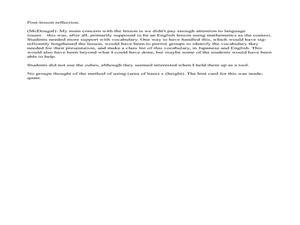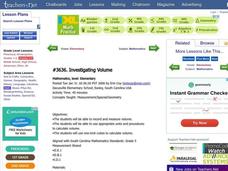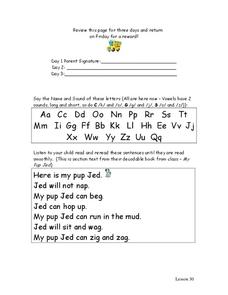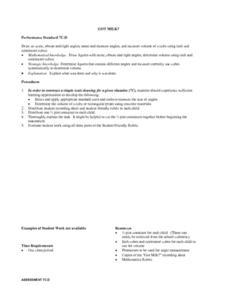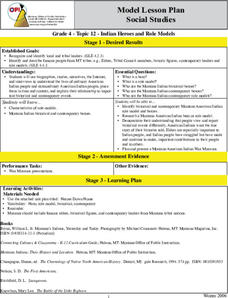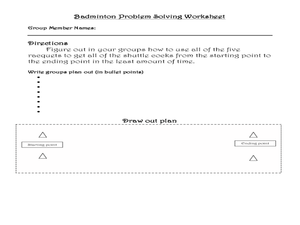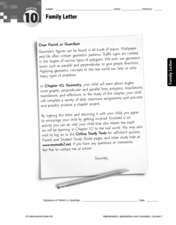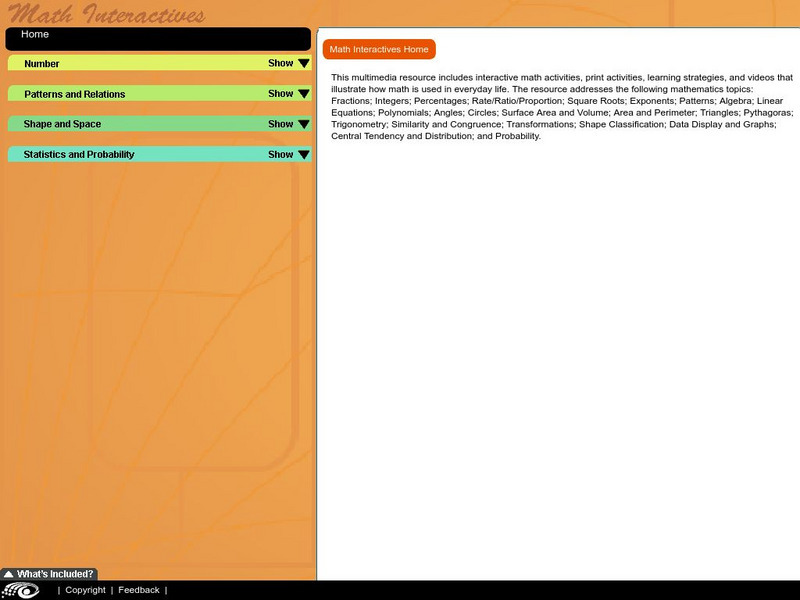Curated OER
Volume of a Stair-Step
Sixth graders calculate the volume of a stair-step. In this volume lesson, 6th graders apply their knowledge of the formula for finding volume. They practice their use of math language since this lesson is presented in a Japanese...
Curated OER
Investigating Volume
Learners investigate the components of volume and use appropriate units and procedures to calculate the volume of several household boxes.
Curated OER
Creating Sand Dunes
Students explain how sand dunes are formed, the different circumstances that effect the movement of or formation of sand dunes, and relate the information gathered to soil conservation. In this sand dunes lesson, students use pans of...
Curated OER
Word and Letter Practice #6
In this word and letter practice worksheet, students say the name and sounds of given letters, read simple sentences, practice reading sight words and practice "chunks" of words.
Curated OER
Got Milk?
Learners measure the angles of a milk carton. They identify and label acute, right, and obtuse angles. Using appropriate tools, students determine the volume of a cube or a rectangular prism. Learners complete worksheets to...
Curated OER
Fall 2003 Midterm Exam #1
Electricity is the focus of this college-level midterm exam. It requres physics learners to answer multiple choice and short answer questions in addition to evaluating several diagrams and graphs. This is appropriate for most high school...
Curated OER
Two for One Box Company
Here is a challenging and thought-provoking math worksheet. In it, learners work together to construct a variety of boxes of different sizes to see if doubling the size of a box really means it can hold twice as much stuff as the...
Curated OER
History: Declaration of Conscience Political Cartoons
Students examine political cartoons depicting opinions about Margaret Chase Smith's Declaration of conscience. After examining the cartoons, they create their own political cartoons about the speech. As an ongoing activity, students...
Curated OER
Shapes are Everywhere
Second graders gain an understanding of geometric shapes and spatial reasoning. They learn the attributes of solid shapes in everyday activities. Students compare geometric shapes to everday objects, finding things that serve a purpose...
Curated OER
River Width
Students determine the level of accuracy needed for computations involving measurements and irrational numbers. They use the correct number of digits in computation to achieve an appropriate unit or level of accuracy when solving...
Curated OER
Political Traditions
Students compare and contrast the political institutions in Greece, Rome, and the United States. In groups, they take this information to determine the influences on James Madison when organizing the republic. They develop a chart and...
Curated OER
George Mason and the Constitution
Students read various articles about the political beliefs of George Mason. In groups, they describe the major events of his life that formed his beliefs and values. They also analyze his contributions to the Constitution and the Bill...
Curated OER
A Picture Is Worth A Thousand Words
Learners examine the cultural and historical significance of certain artists. They use the internet to perform research and prepare a report of analysis of artistic works looking for cultural influences. Students also tie in the...
Curated OER
Geometry Journal: Classifying Solids
In this geometry worksheet, 10th graders respond to journal prompts related to prisms and classifying solid shapes. The two page worksheet contains nine questions. Answers are included.
University City High School
Metabolism Lesson Plan
Not a lesson in the traditional sense, this is a collection of resources with which you can craft a lesson on metabolic processes. It includes an outline of topics, some brief discussion, and a large array of animations, images, and...
Curated OER
Spreadsheet formulas
Students, while in the computer lab, practice using formulas, print options, functions and adjusting column widths while interacting with a spreadsheet program. They modify and use spreadsheets, after being given a scenario, to solve...
Curated OER
Cones, Cylinders, Spheres
Students classify polygons by name and shape. In this geometry lesson, students identify the lateral surface of each conic. They differentiate between cones, cylinders and spheres.
Curated OER
Indian Heroes And Role Models
Fourth graders investigate the concept of heroes and role models within the Native American community. They use primary and secondary resources to answer specific questions intended to bring the students to a definition of Native...
Curated OER
Sports and Exercise Activity
Eighth graders practice utilizing motor skills by participating in different sports activities. In this physical education lesson, 8th graders participate in racquetball, shuttle cock, and baseball style activities in order to...
Curated OER
Fishing for El Nino
Learners explain why fish are in their usual location from the perspective of a worker on a fishing boat. They use clues clues, research, and a fake letter from their friend in North Carolina to determine the cause is El Nino.
Curated OER
Family Activity: Triangles and Quadrilaterals
In this triangles and quadrilaterals worksheet, students solve 7 short answer problems. Students find objects around the house that are constructed from triangles, parallelograms, trapezoids, squares, rectangles. Students sketch the...
Curated OER
Frederick Douglass
Fifth graders are introduced to the novel "Frederick Douglass" and conduct research about his life. The lesson integrates technology while using a library database. It is used as a source of information with access to a reference...
Government of Alberta
Learn Alberta: Math Interactives: Exploring Surface Area, Volume, and Nets
Investigate the concepts of area, volume, 3D shapes, and nets using this interactive Learn Alberta math. The solid shapes focused on this exploration include rectangular and triangular prisms, rectangular and triangular pyramids,...
Better Lesson
Better Lesson: 3 D Figures and Nets
Sixth graders explore cube nets in an effort to understand what properties are common to all nets that form a cube. Students work hands-on with nets and are then pushed to use their experience to visually determine whether other nets...
